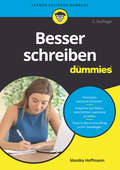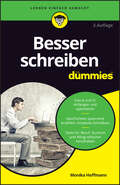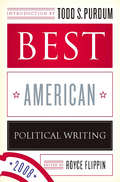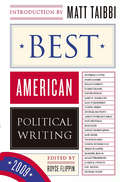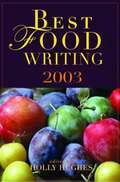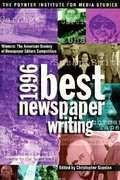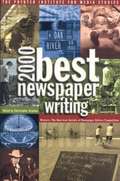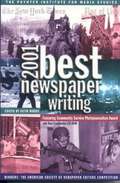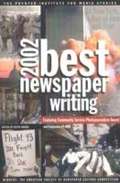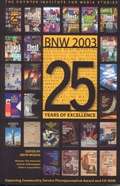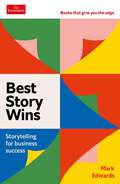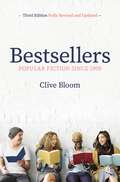- Table View
- List View
Besser schreiben für Dummies (Für Dummies)
by Monika HoffmannSchreiben gehört immer mit dazu. Je besser Sie es draufhaben, desto besser stehen Sie da. Das gilt für Ausbildung und Beruf ebenso wie für jede Online-Präsentation und jedes Buchvorhaben. Hier können Sie etwas dafür tun, dass Ihr Schreiben Ihnen leichter von der Hand geht und beim Leser punktgenau landet. Monika Hoffmann zeigt Ihnen Denkansätze und Techniken, gibt Ihnen Tipps, verrät Ihnen Kniffe und schlägt die passenden Übungen vor. Neu in dieser Ausgabe sind das kreative Schreiben und Online-Texte.
Besser schreiben für Dummies (Für Dummies)
by Monika HoffmannSo finden Sie Ihren Stil Schreiben gehört immer mit dazu. Wer’s kann, ist klar im Vorteil. Das gilt für Ausbildung und Beruf ebenso wie für jede Online-Präsentation und jedes Buchvorhaben. Dieses Buch hilft Ihnen dabei, so zu schreiben, dass Ihre Texte punktgenau beim Leser landen. Es zeigt Ihnen Denkansätze und Techniken, gibt Ihnen Tipps, verrät Ihnen Kniffe und empfiehlt Ihnen die passenden Übungen dazu. Sie brauchen nur mitzumachen, und das Schreiben wird Ihnen leichter von der Hand gehen. Sie erfahren Wie Sie Ihre Texte ideal auf die Zielgruppe zuschneiden Was speziell bei Online-Texten zu beachten ist Wie Sie mit Zeitdruck, Blockaden und Erwartungen umgehen Wie Sie gendersensibel schreiben
Best American Political Writing 2008
by Royce FlippinAn anthology of the very best of American political journalism in a singularly exciting political year.
Best American Political Writing 2009
by Royce FlippinA must-have anthology for political junkies, Best American Political Writing compiles the year's best political stories from a variety of publications and points of view, in a single, comprehensive volume. Culling from the most memorable reporting of what promises to be a thrilling political year, the 2009 American Political Writing edition will include incisive coverage of the new Obama presidency and its impact nationwide, as well as the most pressing political concerns facing America today-from the depressed economy to our participation in wars in Iraq and Afghanistan.
Best Food Writing 2003
by Holly D. HughesBest Food Writing 2003 assembles, for the fourth year, the most exceptional writing from the past year's books, magazines, newspapers, newsletters, and websites. Within its six sections--Stocking the Larder, Home Cooking, Someone's in the Kitchen, Dining Around, The Recipe File, and Personal Tastes--read our best writers on everything from celebrated chefs to extraordinary restaurants, from histories of vital ingredients to food-inspired memoirs. Included are pieces from such stars of the genre as John Thorne, Amanda Hesser, and Calvin Trillin. Selected as required reading by the Culinary Institute of America for all of its undergraduate students, neither cook nor food lover should be without this remarkable annual collection.
Best Newspaper Writing 1981
by Roy P. ClarkBest Newspaper Writing 1981 celebrates the winners of the ASNE's Distinguished Writing Awards, including the Jesse Laventhol Awards, created to honor deadline reporting. It includes interviews with the winners about their craft; the work of 17 other writers who share the lessons they learned; study questions useful to students, teachers, and working journalists; a bibliography; and essays to help readers improve their writing.
Best Newspaper Writing 1982
by Roy P. ClarkBest Newspaper Writing 1982 celebrates the winners of the ASNE's Distinguished Writing Awards, including the Jesse Laventhol Awards, created to honor deadline reporting. It includes interviews with the winners about their craft; the work of 17 other writers who share the lessons they learned; study questions useful to students, teachers, and working journalists; a bibliography; and essays to help readers improve their writing.
Best Newspaper Writing 1983
by Roy P. ClarkBest Newspaper Writing 1983 celebrates the winners of the ASNE's Distinguished Writing Awards, including the Jesse Laventhol Awards, created to honor deadline reporting. It includes interviews with the winners about their craft; the work of 17 other writers who share the lessons they learned; study questions useful to students, teachers, and working journalists; a bibliography; and essays to help readers improve their writing.
Best Newspaper Writing 1984
by Roy Peter ClarkThis is the most useful and up-to-date anthology available for feature writing and introduction to journalism classes. This emphasizes the local reporting, news stories and pedagogical tools to become better writers.
Best Newspaper Writing 1987
by Don FryThe Poynter Institute for Media Studies proudly publishes the ninth volume of its series Best Newspaper Writing, valued since 1979 by students, teachers, and professionals as an indispensable text on clear, effective, and graceful newswriting.
Best Newspaper Writing 1989
by Don FryBest Newspaper Writing 1989 award categories include deadline writing, non-deadline writing, commentary, editorial writing, and state and local government reporting.
Best Newspaper Writing 1993
by Don FryBest Newspaper writing 1993, winners of The American Society of Newspaper Editors Competition.
Best Newspaper Writing 1995
by Christopher ScanlanThis is a compilation of writings by the winners of the American Society of Newspaper Editors Competition for 1995.
Best Newspaper Writing 1996
by Christopher ScanlanBest Newspaper Writing 1996 celebrates the winners of the American Society of Newspaper Editors' Distinguished Writing Awards, including the Jesse Laventhol Awards, created to honor deadline reporting. It includes interviews with the winners about their craft by Christopher Scanlan, Aly Colon, Karen Brown Dunlap, Roy Peter Clark, and Keith Woods of the Poynter Institute faculty; the work of other writers who share the lessons they learned; study questions useful to students, teachers, and working journalists; a bibliography; and essays to help you improve your own writing.
Best Newspaper Writing 1997
by Christopher Scanlan"Best Newspaper Writing 1997" celebrates the winners of the ASNE's Distinguished Writing Awards, including the Jesse Laventhol Awards, created to honor deadline reporting. It includes interviews with the winners about their craft; the work of 17 other writers who share the lessons they learned; study questions useful to students, teachers, and working journalists; a bibliography; and essays to help readers improve their writing.
Best Newspaper Writing 1998
by Christopher ScanlanBest Newspaper Writing for 1998 celebrates the winners of the American Society of Newspaper Editors Distinguished Writing Awards and highlights the best newspaper stories of 1998.
Best Newspaper Writing 1999
by Christopher ScanlanBest Newspaper Writing 1999 celebrates the winners of the ASNE's Distinguished Writing Awards, including the Jesse Laventhol Awards, created to honor deadline reporting. It includes interviews with the winners about their craft; the work of 17 other writers who share the lessons they learned; study questions useful to students, teachers, and working journalists; a bibliography; and essays to help readers improve their writing.
Best Newspaper Writing 2000
by Christopher ScanlanThis volume celebrates the winners of the ASNE's Distinguished Writing Awards, honoring deadline reporting, interviews with the winners and work of 13 other writers, sharing lessons they learned, with study questions useful to students, teachers, and journalists.
Best Newspaper Writing 2001
by Keith WoodsBest Newspaper Writing 2001 celebrates the winners of the American Society of Newspaper Editors Distinguished Writing Awards including the Jesse Laventhol Prizes, created to honor deadline reporting.
Best Newspaper Writing 2002
by Keith WoodsBest Newspaper Writing 2002 celebrates the winners of the ASNE Distinguished Writing Awards, including the Jesse Laventhol Prizes honoring deadline reporting. N.R. Kleinfeld of the New York Times reconstructed the morning of Sept. 11 with stories and stunning details. Jim Dwyer's short stories in the New York Times, resurrected from the smallest pieces of Sept. 11 debris, accomplish a feat that Dwyer himself describes in one of his poignant stories. The Wall Street Journal staff, amid a cloud of personal grief and national uncertainty, produced stories so stirring, encompassing, and complete that they remained relevant and vibrant long after Sept. 11. John McCormick, an editorial writer for the Chicago Tribune, displays amazing range -- from the contradictions of praying for peace amid war in Afghanistan, to a tribute to a murdered Chicago cop. Steve Lopez's storytelling always surprises, whether he's chronicling the unfolding tragedy of Sept. 11, or knocking back a six-pack of beer and a dozen doughnuts in the name of journalistic inquiry. Anne Hull of the Washington Post explores the gentrification of a neighborhood and the aftershocks of Sept. 11. Ellen Barry of the Boston Globe writes of the "Lost Boys" of Sudan, and their odyssey from African cattle herders to urban teens. J. Albert Diaz of the Miami, Herald captures the elusive concept of the American Dream.
Best Newspaper Writing 2003
by Keith WoodsBest Newspaper Writing 2003, the 25th anniversary of this prestigious series' publication, celebrates the winners of the ASNE Distinguished Writing Awards, including the Jesse Laventhol Prizes honoring deadline reporting.
Best Newspaper Writing 2005
by Aly ColónThe Poynter Institute once again brings you the year's best newswriting and community service photojournalism, showcasing the winners and finalists of the American Society of Newspaper Editors annual competition. The perfect reader for aspiring journalists, Best Newspaper Writing 2005 offers a wide array of exemplary writing and photojournalism, providing quality models students can analyze and emulate.
Best Practice Workplace Negotiations
by Richard LueckeBest Practice Workplace Negotiations offers a systematic approach to developing negotiating skills. It serves as an introduction to current best practices in negotiation that can be applied across a broad range of business situations. This up-to-the-minute course covers win-win vs. win-lose negotiations; the BATNA concept (best alternative to a negotiated agreement—what every negotiator should have in his mind before entering into any negotiation); walk-away price, or reserve point; negotiation as a logical set of process steps—preparation, initial moves, application of tactics, and post-deal evaluation; and the power of persuasive communication in negotiations.
Best Story Wins: Storytelling for Business Success (Economist Books)
by Mark EdwardsAn inspiring, practical, and timely new guide on how to harness the power of storytelling in our communications at work. Whether you're standing up in front of a crowd at a conference or chatting with a colleague in an elevator, storytelling is the most effective way to get your point across. It works in ninety-second Superbowl television spots, it works in ten-second social media formats, and it works in that email you have to fire off in five seconds flat. Why? The short answer is that people don't make decisions based on logic. They make decisions based on emotions. To persuade, influence, and inspire, you need to make an emotional connection. And storytelling is the best way of doing that. Journalist-turned-business coach Mark Edwards has developed his own methodology for telling compelling stories at work. Best Story Wins shows how storytelling will make better communicators of us all.
Bestsellers: Popular Fiction Since 1900
by Clive BloomThis book charts the publishing industry and bestselling fiction from 1900, featuring a comprehensive list of all bestselling fiction titles in the UK. This third edition includes a new introduction which features additional information on current trends in reading including the rise of Black, Asian and LGBTQIA+ publishing; the continuing importance of certain genres and up to date trends in publishing, bookselling, library borrowing and literacy. There are sections on writing for children, on the importance of audiobooks and book clubs, self- published bestsellers as well as many new entries to the present day including bestselling authors such as David Walliams, Peter James, George R R Martin and far less well known authors whose books s sell in their thousands. This is the essential guide to best-selling books, authors, genres, publishing and bookselling since 1900, providing a unique insight into more than a century of entertainment, and opening a window into the reading habits and social life of the British from the death of Queen Victoria to the Coronavirus Pandemic.
